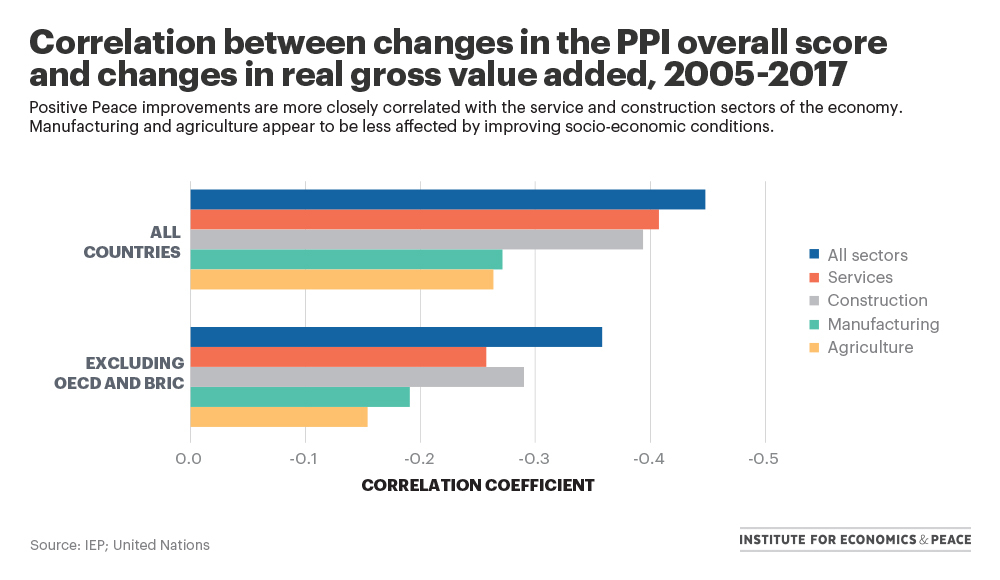New research shows the links between business prosperity and increasing Positive Peace.
The services and construction sectors respond better to improvements in Positive Peace, while agriculture and manufacturing are not as reactive, research has found.
Findings from the Institute for Economics and Peace showing the dynamic correlation between Positive Peace and macro-economic indicators suggests corporate activity is strongly associated with the attitudes and institutions that lead to peaceful societies.
While Positive Peace is associated with business subsectors in different ways, IEP found the service sector is the most sensitive to improvements in the Positive Peace Index, with a dynamic correlation coefficient of -0.41. The link appears to be particularly strong for countries within the Organisation for Economic Co-operation and Development (OECD), and newly advanced economies within the “BRIC” group, including countries such as Brazil, Russia, India and China.
The service subsector has also experienced strong growth on the back of Positive Peace improvements in non-OECD, non-BRIC nations. Some of this growth has been domestically oriented, as seen in Bhutan’s fast growing health, education and asset ownership services, but there has also been a growing presence in global service markets, for example in Ethiopia’s fast development in international air travel and telecommunications.
Construction represents the next sub-sector with the highest dynamic correlation with Positive Peace, with the coefficient estimated around -0.39. The subsector involves building activity, development of infrastructure assets and installation of heavy fixed equipment.
“A number of countries recently showing socio-economic improvements have experienced construction booms.”
Laos recorded strong growth in construction on the back of new electricity production projects in the Mekong tributaries and from renewed investment in real estate. Panama’s construction activity has been buoyed by a government capital investment program that helped build a public metro system in Panama City. Azerbaijan experienced a construction boom that saw rapid urban expansion in and around the capital Baku. Since 2005, these countries have recorded substantial improvements in the Positive Peace Index overall score.
IEP’s research also found that agriculture and manufacturing are not as responsive to improvements in Positive Peace. This is especially the case for non-OECD, non-BRIC nations, where the dynamic correlation coefficients are particularly low in absolute terms.
In high-income countries, agriculture is well-mechanised and farming is usually performed in large scale with industrial techniques. In these circumstances, improvements in Positive Peace may lead to better economic conditions including cheaper funding, access to more efficient equipment and easier access to price guarantees through financial derivative markets.
Agriculture in middle- to low-income countries usually involves small scale operations and little-to-no mechanisation. In these conditions, it is possible that weather and geographical constraints exert greater impact on yield than Positive Peace factors.
IEP investigated the dynamic correlation between between Positive Peace and several macro-economic indicators.
Dynamic correlation gauges how changes in one variable relate to changes in another, without necessarily implying causation. While the analysis of static correlations provides a snapshot of the state of a system at a given time, dynamic correlations show how its internal structure changes over time.
Analysis of dynamic correlations can highlight areas of a system that tend to develop more slowly than others, or growth bottlenecks. It can also help policymakers identify low-hanging fruit: areas more responsive to improvements in Positive Peace that may kick-start virtuous growth cycles. By assuming that observed dynamic relationships will continue in the future, dynamic analysis can be used to help predict socio-economic outcomes.



